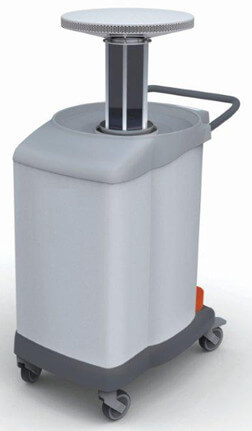Can a robot clean a hospital room as efficiently as a human? Researchers are testing the effectiveness of a germ-killing robot designed to clean hospital rooms, a robot that could be the key to preventing the spread of superbugs and ultimately saving lives

[Translation by Dr. Nachmani Moshe]
Can a robot clean a hospital room as efficiently as a human? Researchers are examining the effectiveness of a germ-killing robot designed to clean rooms in a hospital, a robot that could be the key to preventing the spread of superbugs and ultimately saving lives.
Researchers at the University of Texas are testing the effectiveness of a germ-killing robot for cleaning hospital rooms, a robot that could be the key to preventing the spread of superbugs and ultimately saving lives. Maintaining the cleanliness of treatment and hospitalization rooms in hospitals is essential to prevent the spread of infections from one patient to another, to visitors and staff members. Surfaces that are everywhere in the hospital, for example - treatment tables, bed rails, device keys and safety rails, may be a substrate for the accumulation of antibiotic-resistant bacteria, which may be challenging to treat and in some cases even fatal. "A typical hospital with 100 inpatient beds is responsible for 20-10 infections that originate in the hospital every year," explains the lead researcher. "Our goal is to reach a rate of zero infections."
Besides saving lives, hospitals now have a financial incentive to reduce hospital-acquired infections: starting in 2017, the US federal government will dramatically reduce medical insurance payments to hospitals where excess incidents occur under specified circumstances, such as hospital-acquired infections. Since the current method of cleaning hospital rooms relies heavily on maintenance workers, who have a high turnover rate, the researchers focused on using technology to prevent hospital-born infections. In a focused manner, the study examines the effectiveness of using a system for emitting ultraviolet radiation using a laser beam developed in Texas. These researchers were the first to test this system since it was developed in 2011.
The device – which the lead researcher admits bears a striking resemblance to the fictional robot from the Star Wars film series known as R2-D2 – has a large saucer-shaped head that rises above a pole and is capable of being raised to reveal a bulb filled with xenon gas. When the system is activated, a high electric current passes through the bulb and causes the emission of ultraviolet radiation that damages the DNA of the bacteria and destroys them. Last year, researchers published a study that compared the effectiveness of manual disinfection alone versus manual disinfection combined with ultraviolet radiation. The study found that the combined disinfection (manual + radiation) destroyed more than 90% of the bacteria, compared to only 70% in the manual disinfection. It should be especially noted that the combined disinfection was able to destroy 99% of the bacteria resistant to antibiotics.
The latest study by the team of scientists, which was published earlier this year in the scientific journal American Journal of Infection Control, focused on the effectiveness of the radiation disinfection alone. In this study it was found that within only 12 minutes, the ultraviolet radiation system reduced the amount of bacteria in the room by 70% - the same rate achieved through manual disinfection. The lead researcher emphasizes that he would never recommend that a hospital use only the radiation system, but he believes that it has value in itself as a "safety net" in terms of destroying those bacteria that normal cleaning usually misses. Today, the system is operated in about 250 hospitals and the researcher believes that in the coming days it will become standard equipment in all hospitals.
the article
The news about the study

3 תגובות
Where is the Ministry of Health in the picture? We must bring this system to Israel. It can be perfected. Even create a stationary device in every room.
Haim,
I don't think the article implies that. The radiation definitely damages human DNA as well (it is, after all, the exact same molecule). I think the idea is that they do it when there are no people in the field.
The article seems to imply that the radiation damages the DNA of the bacteria only, not humans. Why? And why was this not specifically mentioned?
It was worth adding a reference to this matter.